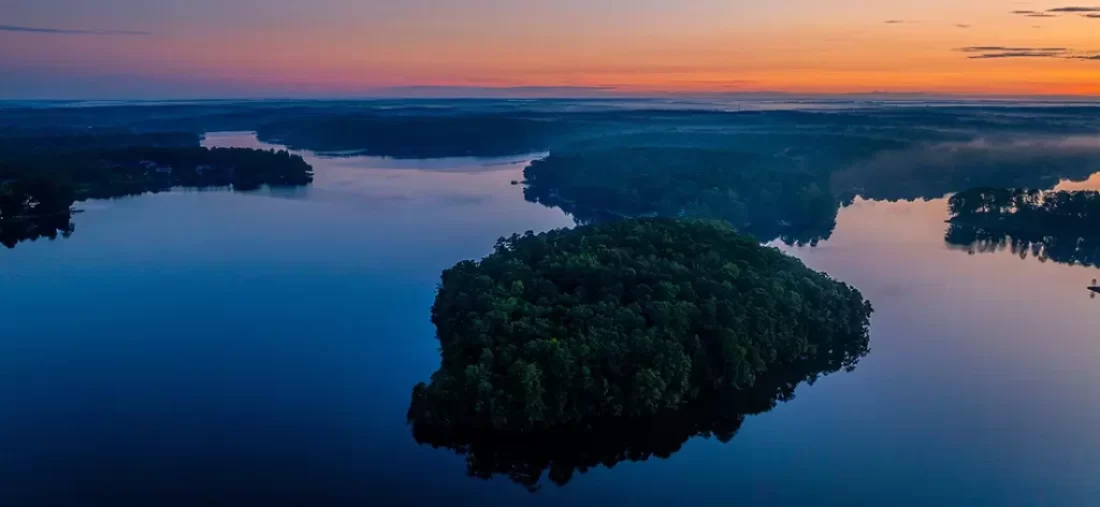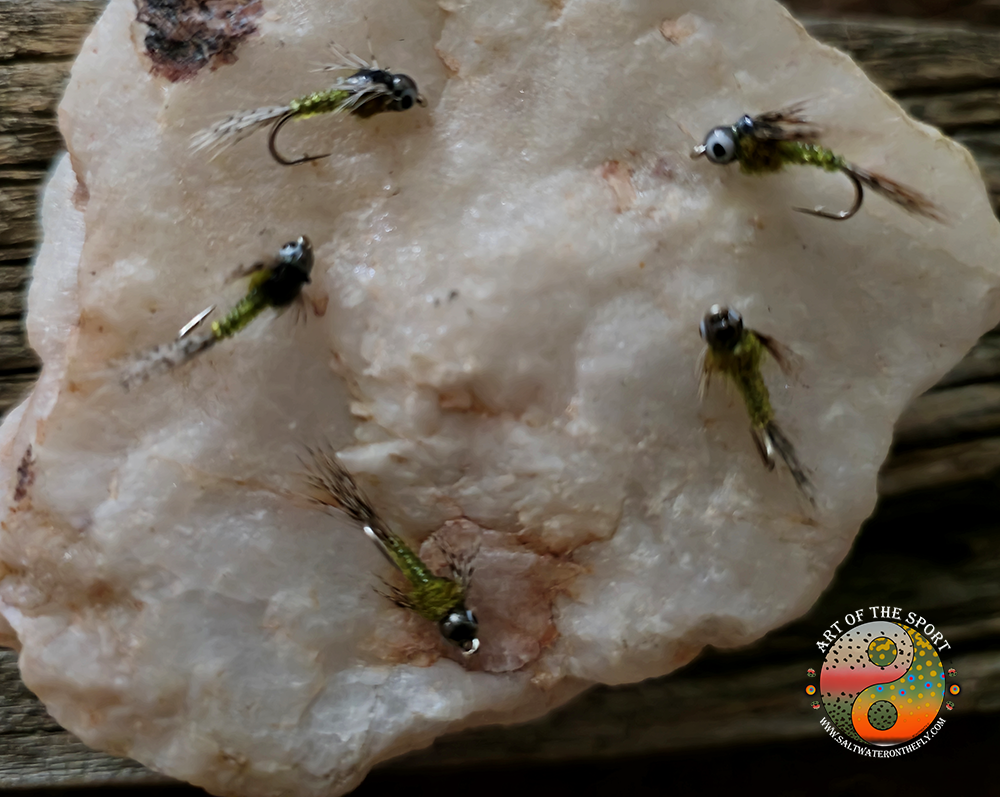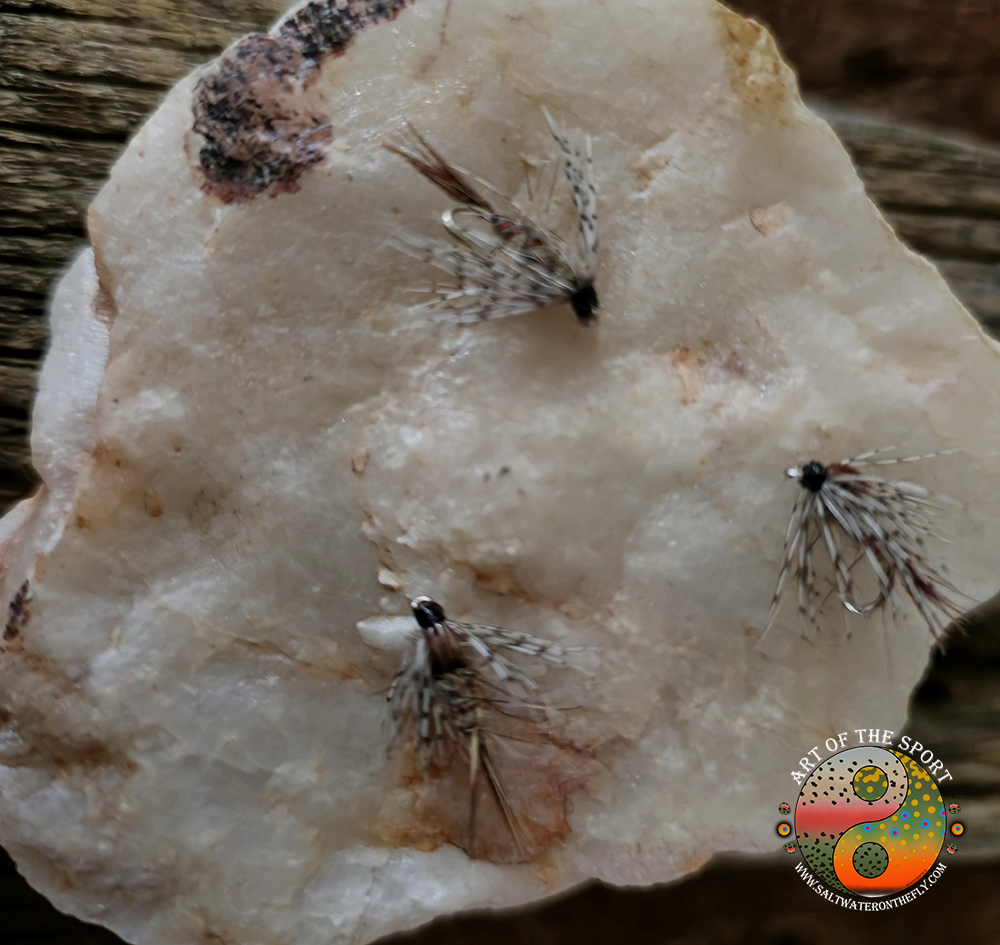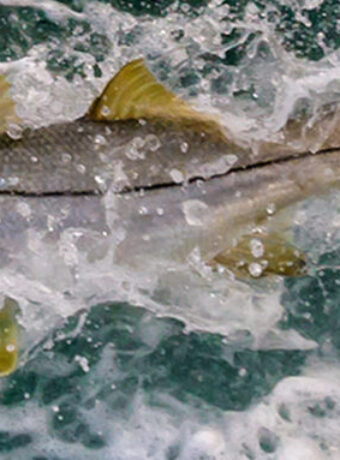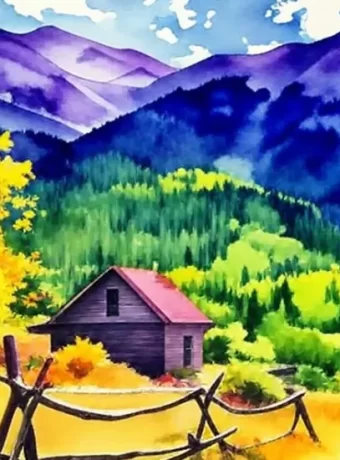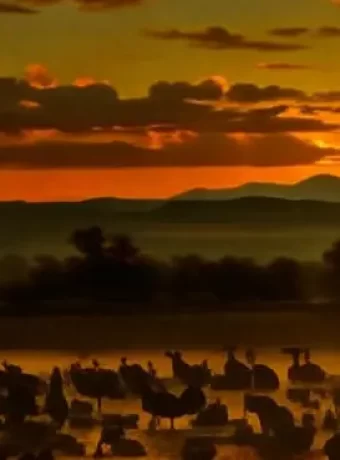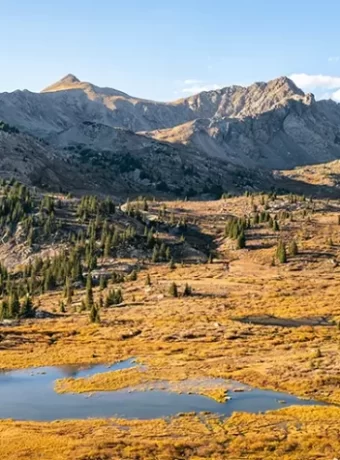Best Georgia Lakes for Crappie Fly Fishing Adventures
Are you picturing it yet? The sun is peeking over the Georgia pines, and your fly rod is bent double with a slab crappie pulling back. Georgia may be known for its peaches and hospitality, but the Peach State also is hiding some fantastic crappie fly fishing. Forget those small mountain streams for a minute because some of the very Best Georgia Lakes for Crappie Fly Fishing offer incredible fishing opportunities for fly anglers.
For anglers who enjoy the art of fly fishing, Georgia provides a wealth of options. Many picture trout when they imagine flinging flies, but the fly fishing scene in Georgia shouldn’t be ignored. And who knows…maybe one day soon they’ll be writing odes to those adventurous souls trading tiny midges for crappie jigs.
So, ready to try a different type of fly fishing? Or are you interested in learning which Georgia lakes hold the most potential for the sport? If that sounds interesting, then keep reading to discover the secrets of landing slab crappie on a fly rod and get ready for the crappie fly fishing.
Table of Contents
Gear Up for Success: Essential Flies and Equipment
Selecting the right flies and equipment is important for landing crappie. Sure, you can get by with most setups, but there are optimal setups, too. The gear and fly choice needs to be tailored to the species to greatly enhance the chances of success.
Choosing the Right Flies for Georgia Crappie
Crappie aren’t too picky, but they do have preferences. Selecting the correct flies requires anglers to adapt their tactics to match conditions. Here’s a guide to what works:
- Small Streamers: These flies imitate small fish and insects that crappie love.
- Woolly Buggers (sizes 8-12): These are versatile flies, effective year-round in multiple colors.
- Clouser Minnows (sizes 8-10): This pattern works great for mimicking minnows. Minnows are a key food source for crappie, too.
- Minnow-Imitating Flies: If it has tinsel or marabou tails, then it should entice bites. Black-Nosed Dace or Muddler Minnows will work great for this purpose.
- Flashy Attractor Flies: Think bright colors or rubber legs that provoke those strikes. Colors like pink, chartreuse, black, olive, and yellow can make a big difference.
- Nymphs and Wet Flies: You might want to try Hare’s Ear or Prince Nymph patterns. This can be useful when crappie are feeding on insects.
Think of attractor patterns like that flashy lure you had as a kid. Remember how all the other kids told you it wouldn’t catch anything, but you went out and caught a stringer full? Flashy patterns work great, and remember to switch colors regularly because keeping the fish guessing will pay off.
Essential Equipment for Georgia Crappie Fly Fishing
Now you’ve picked the flies, so let’s talk about the delivery method. Having the right fly rod and line combo can make all the difference in presenting flies to those finicky fish.
- Fly Line: Use a floating fly line for shallow waters or a sink-tip line for deeper presentations.
- Rod and Leader: Go with a 4-6 weight rod with a 7-9 foot leader (3X-4X tippet) for your DIY setup.
- Light to medium action rod and reel: When fly fishing for crappie, use a light to medium action rod and reel with a floating line.
Now here’s the biggest question, are you prepared to potentially lose some fish tackle to get the biggest fish? Structure holds crappie so being willing to get in those snags means landing those fish.
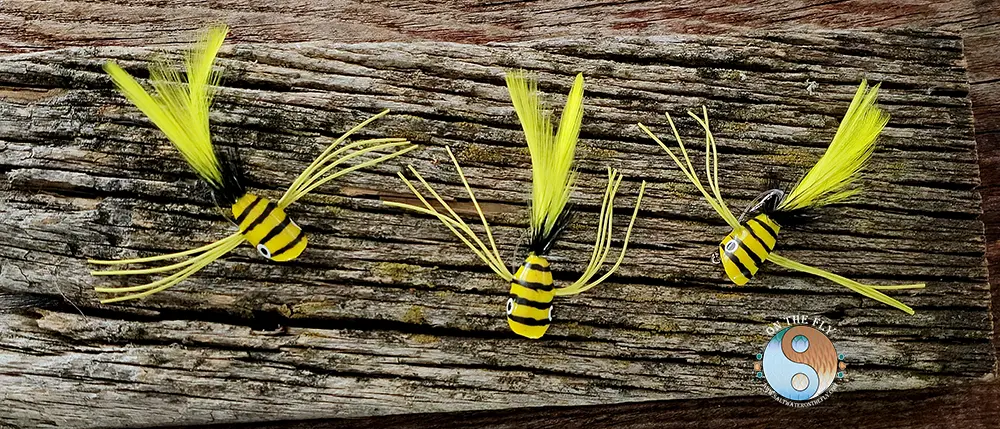
Fly Fishing for Crappie a small arsenal of flies is always the ticket to a successful day on the water. Summers surface action on poppers is always fun, even if your set is late a bit too, much.
Small bright woolly buggers even attract bass and other panfish. Learn more about fly fishing for panfish.
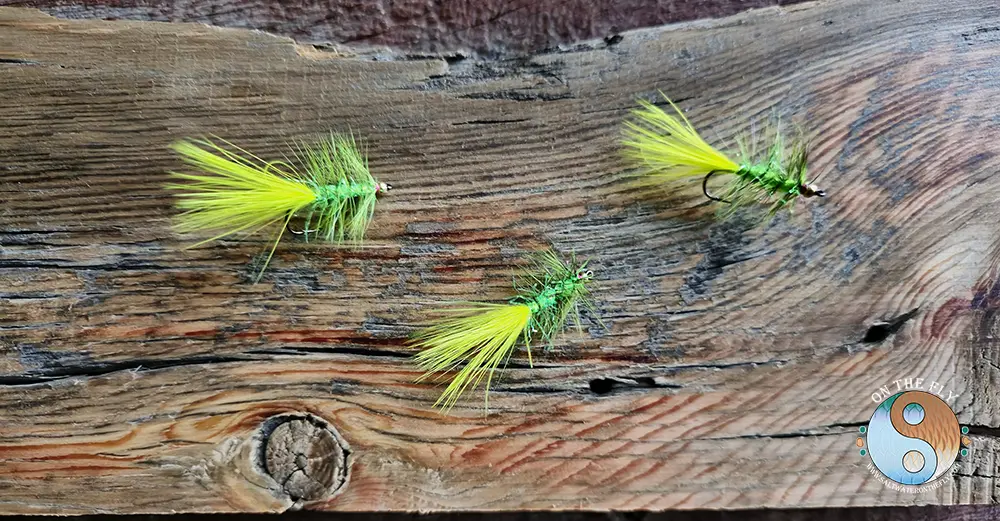
Fluorescent Green Woolly Bugger
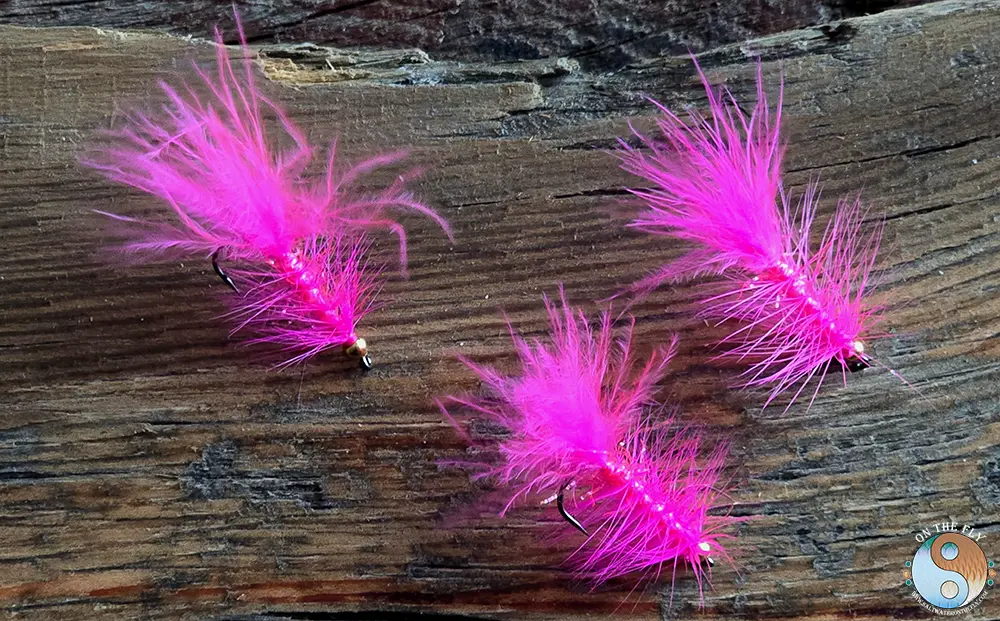
Fluorescent Pink UV Woolly Bugger
Guide on How to Use Poppers for Crappie Fly Fishing in Georgia:
When to Fish
- Best Seasons: Focus on spring (April-May) and fall (September-October) when crappie move into shallower waters in Georgia lakes. These times align with their spawning and feeding patterns.
- Time of Day: Fish during early morning or late evening, as crappie are more likely to be active near the surface during these periods, especially on calm, sunny days.
Where to Fish
- Key Locations: Target areas with submerged structures such as brush piles, docks, or vegetation. Popular Georgia lakes for crappie include:
- Lake Lanier
- Lake Oconee
- Lake Sinclair
- These spots provide cover where crappie congregate, increasing your chances of success with poppers.
Gear Setup
- Fly Rod: Use a 3-6 weight fly rod, which is light enough for crappie yet suitable for casting small poppers.
- Poppers: Choose small poppers (size 8-12) to match the size of insects or baitfish crappie feed on. Examples include patterns mimicking grasshoppers, dragonflies, or small baitfish.
- Color Selection:
- Murky Water: Opt for bright colors like chartreuse or white for better visibility.
- Clear Water: Use natural tones like brown, black, or green to blend with the environment.
Technique
- Casting: Cast your popper near structures or vegetation where crappie might be lurking.
- Retrieve: Use a slow, deliberate retrieve with these steps:
- Give short, sharp pulls on the line to make the popper create a popping sound on the surface.
- Follow with pauses to let the popper sit still, mimicking a struggling insect or small fish.
- Why It Works: The popping noise attracts crappie by simulating surface prey, and they often strike during the pause when the popper is stationary.
Additional Tips
- Crappie Behavior: While crappie typically feed below the surface, poppers can entice them upward by creating a disturbance. If they approach but don’t strike, consider switching to a subsurface fly as a follow-up.
- Weather Impact: Poppers work best on calm days when the water surface is undisturbed. Windy conditions may reduce their effectiveness due to natural surface noise.
- Regulations: Check Georgia’s fishing regulations for size and bag limits on crappie, though no specific rules apply to using poppers.
By fishing at the right time, targeting structure-rich areas, and using this popping technique with the proper gear, you can effectively use poppers to catch crappie in Georgia’s lakes. This method leverages their aggressive feeding nature, making for an exciting fly fishing experience!
Prime Locations: Exploring the Best Georgia Lakes for Crappie Fly Fishing
The real key to the entire process: where are you even planning to go? In that case, you should be looking at which of the many lakes are suited for fly fishing. Georgia is home to fantastic crappie waters, from sprawling reservoirs to smaller lakes. Let’s explore some of the premier spots known for great crappie fly fishing opportunities.
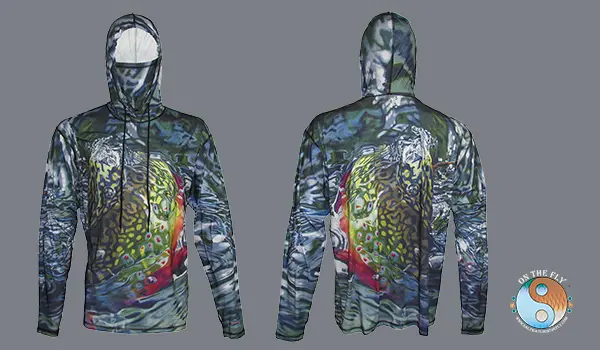
Playing in the outdoors requires the right clothing for a great experience. Sun, Rain, Cold, or Blisters from stripping streamers. We have you covered. Brook Trout Graphic Hoodie is a UPF-50 sun protection with many other built in features. Sun protective gloves in Peacock Bass Graphic Glove Design.
Even a great all around fly rod in a nine foot six weight.
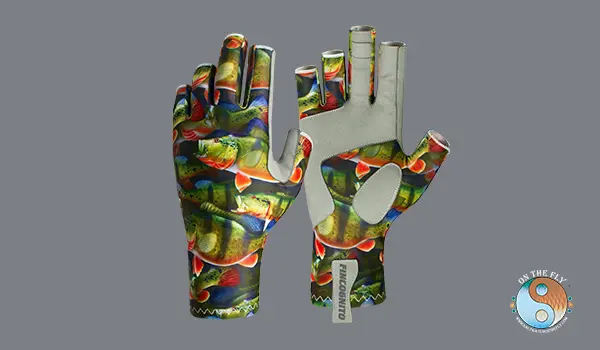
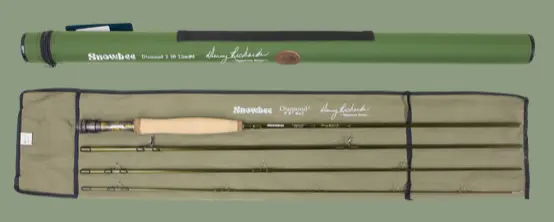
Fly Fishing Crappie on Lake Lanier
Crappie fishing on Lake Lanier can be a blast. This awesome lake is in Hall County, Georgia. It has loads of crappie, and they’re waiting for you to catch them! You’ll find mostly white crappie here, plus some black crappie too.
Best Times for Crappie
When should you hit the lake? Spring and fall are your best bets. The fish are more active then. They’re also closer to the surface.
What Flies to Use
Crappie aren’t too picky. However, some flies work better than others. Here are some of the top choices for Lake Lanier:
- Small jigs in white, chartreuse, or yellow.
- Streamers like the Woolly Bugger or Muddler Minnow.
- Dry flies like the Elk Hair Caddis or Parachute Adams.
Small jigs work great. White, chartreuse, and yellow are good colors. Streamers like the Woolly Bugger look like small baitfish. This drives crappie wild. Dry flies like the Elk Hair Caddis imitate insects on the surface. This can bring crappie up for a snack.
DIY Tips and Tricks
To catch more crappie, here are some tips:
- Use a light to medium action rod and reel.
- Use a floating line. This lets you fish on the surface.
- Fish near submerged logs, rocks, or weed beds. Crappie like structure.
- Change your retrieve to mimic baitfish.
- Move around to find active schools of crappie.
If you love DIY adventures, then grab your fly rod. Get ready for some awesome Georgia crappie fly fishing!
Lake Oconee: Central Georgia’s Crappie Paradise
Central Georgia’s Lake Oconee has good amenities like boat rentals and fishing charters. The abundant white and moderate black crappie populations are hard-fighting fish, too. To find a good number of fish, look around submerged rocks and drop-offs during the spring and early summer months.
Keep an eye out for alligators since they frequent this region of Georgia. Most likely they will be infrequent to the area, but always practice safety.
Fly Fishing Crappie on Lake Oconee
Crappie fishing on Lake Oconee is a blast! This lake in central Georgia is known for having a lot of crappie. Lake Oconee is a popular place for anglers because it has good amenities. You can find boat rentals and fishing charters. So, it is super easy to get out on the water. But, you can always go the DIY route!
What flies should you use? Well, crappie aren’t too picky. But, some flies work better than others. For Lake Oconee, try these:
- Soft-hackled flies in white, pink, or yellow. These colors can attract crappie.
- Small nymphs like the Hare’s Ear or Pheasant Tail. Crappie eat insects, too!
- Topwater flies like the Popper or Gurgler. These are fun to watch!
Spring and summer are the best times to fish here. The crappie are more active then. Target areas around submerged rocks and drop-offs. These are spots where crappie like to hang out. If you want to try some DIY crappie fly fishing, you can rent a boat. Look for shallow areas with submerged structure.
You’ll learn that a light to medium action rod and reel is best. Use a floating line. This will help you present your fly well. Vary your retrieve. Change it up to imitate the movement of baitfish or insects. Don’t be afraid to move around the lake. Find where the active schools of crappie are.
Lake Hartwell: Bordering the Carolinas
Straddling the Georgia and South Carolina border, Lake Hartwell offers great fly fishing. Anglers can chase abundant white crappie, but it’s the lake’s scenic views that really attract fisherman. Shallow areas with submerged vegetation and wood cover are key in the spring and early summer months here, too.
Interestingly, this lake is one of the Top Fishing Parks in Georgia, making it worth the visit. Just don’t forget to take it easy and stay hydrated, but catch some crappie and remember this: Fishing here requires a fishing license.
Fly Fishing Crappie on Lake Hartwell
Want to try fly fishing crappie? Lake Hartwell in Georgia is a great spot. It has lots of crappie, and you can have fun doing it yourself. You’ll learn why Lake Hartwell is awesome for DIY crappie fly fishing.
Why Lake Hartwell?
Lake Hartwell has many white and black crappie. The crappie population is abundant. Spring and early summer are the best times to fish. The fish hang out in shallow areas. Look for submerged plants and things under the water. These spots are perfect for crappie fly fishing.
What Flies to Use
Choosing the right flies is key. Here are some good ones for Lake Hartwell:
- Small jigs: White, chartreuse, or yellow colors work well.
- Soft-hackled flies: Use yellow, orange, or red.
- Dry flies: Royal Wulff or Adams patterns are great.
DIY Tips for Success
Want to catch more crappie? Here are some tips:
- Use light gear: A light to medium action rod is best. Use a floating line.
- Fish near things underwater: Look for logs, rocks, or weeds.
- Change how you reel: Try different speeds to see what works.
- Move around: Find where the crappie are active.
Make sure you check the fishing rules. Get any permits you need before you go. Enjoy your DIY crappie fly fishing trip on Lake Hartwell!
Lake Blackshear: Southern Georgia’s Hidden Gem
In southern Georgia, Lake Blackshear gives good fishing and some handy resources. Some of those amenities would be things like boat rentals and fishing charters to help the weekend angler dial it in. Target shallow areas with submerged vegetation and structures during the spring and early summer months for the best fishing opportunities.
Be aware that Blackshear has a reputation. The locals know Lake Blackshear as Georgia’s most alligator-infested lake. Stay vigilant in your pursuits.
Fly Fishing Crappie on Lake Blackshear
Fly Fishing Crappie on Lake Blackshear Looking for a fantastic crappie fly fishing spot in Georgia? Lake Blackshear should be on your list. This lake in southern Georgia is a crappie fishing hotspot. It also has boat rentals and fishing charters if you need them. It’s known for its abundant crappie population. This makes it a prime destination for anglers of all skill levels. What makes Lake Blackshear so special for crappie? It’s the ideal habitat. You’ll find shallow areas filled with submerged vegetation and structures. These are perfect for crappie to thrive. Spring and early summer are the best times to fish here. This is when crappie are most active in these shallow zones. Here are some DIY tips to make the most of your fly fishing trip: * Target areas with submerged vegetation and structures. * Use small jigs in white, chartreuse, or yellow. * Try streamers like the Woolly Bugger or Muddler Minnow. * Consider dry flies like the Elk Hair Caddis or Parachute Adams. Fly fishing for crappie on Lake Blackshear is an experience you won’t want to miss. Get ready for some thrilling action on the water.
Lake Allatoona: Close to Atlanta
This one will be an easily accessible trip being so close to Atlanta. The northern side of the Etowah River arm provides the biggest payoff in spring and early summer. Also, creeks like Kellogg, Illinois, Sixes, and Sweetwater are going to be good crappie spots.
Lake Allatoona has populations of black and white crappie with the black species being more common. Red Top Mountain State Park is an option as a home base for longer stays and provides convenient lake access.
I spent 2 months one fall living on Lake Allatoona.
Fly Fishing Crappie on Lake Allatoona
Want to try fly fishing for crappie? Lake Allatoona, northwest of Atlanta, is a great place to start. This lake is known for its healthy crappie populations. You’ll also find bluegill and bass here. It’s easy to get to, which is a bonus for DIY anglers.
Where to Find Them
The northern side of the Etowah River arm is a good bet. Check out creeks like Kellogg, Illinois, Sixes, and Sweetwater. These spots are known for good crappie fishing. Target submerged brush, stumps, docks, or weed beds. Crappie like to hang out where there’s structure.
Best Flies for Lake Allatoona Crappie
Crappie aren’t too picky, but some flies work better than others. Here’s what to try:
- Small Streamers: Woolly Buggers (sizes 8-12) are versatile. Clouser Minnows (sizes 8-10) imitate minnows well.
- Minnow-Imitating Flies: Use flies with tinsel or marabou tails (2-2.5 inches long). The Black-Nosed Dace or Muddler Minnow are good choices.
- Flashy Attractor Flies: Flies with rubber legs or bright colors can trigger strikes. Try pink, chartreuse, black, olive, and yellow. Change colors every hour to keep fish interested.
- Nymphs and Wet Flies: Small options like the Hare’s Ear or Prince Nymph can work. Use these when crappie are feeding on insects.
Gear to Use
Use a floating fly line for shallow waters. If crappie are deeper, try a sink-tip line. A 4-6 weight rod with a 7-9 foot leader (3X-4X tippet) is perfect. This DIY setup will work great on Lake Allatoona.
Tips for Success
- Presentation: Let your fly sink to the right depth. Use slow retrieves with pauses. Crappie often hit on the fall.
- Local Conditions: Check local fishing reports or tackle shops. Water levels, weather, and fish behavior can change quickly.
With the right flies and techniques, you’ll have a great time fly fishing for crappie on Lake Allatoona. Enjoy your adventure!
Other Notable Georgia Crappie Fishing Lakes
Several more lakes deserve consideration, especially for die-hard crappie enthusiasts:
- Clarks Hill Lake: Straddling the Georgia and South Carolina border, Clarks Hill Lake is massive. With a long shoreline, it gives you plenty of space to hook a slab.
- Lake Sinclair: Another central Georgia gem with similar characteristics to Lake Oconee. You’ll find consistent crappie fishing here with similar techniques that produce fish.
- Lake Seminole: Way down south by Florida sits Seminole. You can have fun catching bass, but the crappie fishing is amazing.
Here is a table showing some of the best crappie lakes in Georgia.
| Lake Name | Location | Primary Crappie Species | Key Fishing Times | Notable Features |
|---|---|---|---|---|
| Lake Lanier | Hall County | White Crappie | Spring and Early Summer | Submerged structures, brush piles, drop-offs. |
| Lake Oconee | Central Georgia | White and Black Crappie | Spring and Early Summer | Submerged rocks, drop-offs. |
| Lake Hartwell | Georgia/South Carolina Border | White Crappie | Spring and Early Summer | Scenic views, submerged vegetation. |
| Lake Allatoona | Near Atlanta | Black and White Crappie | Spring and Early Summer | Etowah River arm, Kellogg, Illinois, Sixes, and Sweetwater creeks. |
| Lake Blackshear | Southern Georgia | Unknown | Spring and Early Summer | Submerged vegetation, structures. |
| Clarks Hill Lake | Georgia/South Carolina Border | Unknown | Unknown | Long shoreline. |
| Lake Sinclair | Central Georgia | Unknown | Consistent Fishing | Similar to Lake Oconee. |
| Lake Seminole | Southern Georgia (near Florida) | Unknown | Unknown | Bass and crappie fishing. |
The Thrill of the Chase: DIY Tips for Georgia Crappie Fly Fishing
OK, you know where to go, but do you know how to catch them consistently? Consider these “do it yourself” strategies for your crappie adventure. These strategies will maximize the time you have available to be on the water.
Timing Your Trip: When to Fish for Crappie in Georgia
Timing is indeed critical if you don’t want to fish all day to no avail. Understanding seasonal patterns impacts how well your fishing trips can go. Here’s a seasonal breakdown:
- Spring (April and May): This is the BEST time for crappie fishing, due to the water temperature reach 45°F-50°F. They head to those shallow areas to spawn once the water gets to 55°F. This time finds them aggressive and willing to hit your flies.
- Early Summer and Fall: If you want to keep going during these times, it can be tricky. The crappie move deeper, so it’s important to adjust your approach and spot selection to meet the deep move.
- Year-Round Potential: OK, if you are REALLY dedicated, you can still find some fish. Winter and late summer won’t produce tons of fish, but if you want to chase one, then give it your all. Learn about Fly Fishing for Georgia’s Trout population, you may be surprised.
Here’s what you should do if you’re serious about this… plan that trip during the spring spawn. Set that PTO, skip out of school, just make sure you are on the water chasing those springtime crappie.
Essential Techniques for Luring Crappie
Once the trip is booked, then the real game is getting crappie to hand. Having a few tricks will help put more fish in the boat for a fish fry. So think of these factors when choosing a technique.
- Target Structure: Crappie love hiding around brush, stumps, docks, and weed beds, so give those a try.
- Presentation: Be patient and allow your fly to drop to where the fish are staged, often they’ll grab it as it falls. Use a slow retrieve. It will give the fish more time to track the fly and smack it.
- Check Local Conditions: Keep an eye on those water levels, weather conditions, and even recent fishing reports to point you to the active zones. Tackle shops can be your new best friend.
Have you ever noticed fish following your fly, only to turn away? Experiment with a twitching retrieve or erratic movement, enticing a reaction strike. Varying retrieves can make those tentative followers commit to biting.
Respect the Resource
Conservation ensures great fishing for years to come. Obeying local rules is extremely important, as well as the purchase of necessary licenses.
In Georgia, everyone aged 16 and older requires a fishing license. Buying the license from the Electronic Georgia Licensing (EGAL) system ensures the conservation of Georgia’s resources. In that case, it might be worthwhile to thumb through some publications about fishing to help.
What better reason than to chase some awesome Georgia slabs in the spring? Several publications may be of use in better preparing you for chasing those giant crappie such as: they are. It is especially vital you take safety very seriously and exercise the highest level of precaution on any body of water in the country to protect you and other patrons. It is very important to practice “catch and release” so the Georgia crappie fishery has sustainability for years to come.
FAQs about Best Georgia Lakes for Crappie Fly Fishing
Where is the best crappie fishing in Georgia?
Some of the best crappie fishing lakes in Georgia include Lake Lanier, Lake Hartwell, Lake Oconee, Lake Sinclair, Lake Blackshear, and Lake Seminole. Each offers a fishing opportunities with abundant crappie populations and submerged structures that attract fish.
What is the best time to catch crappie in Georgia?
The best time to catch crappie in Georgia is during the spring and early summer. This is when crappie are most active due to spawning, and they tend to congregate in shallow areas, making them easier to target.
What lake is the crappie capital of the world?
While there isn’t a definitive “crappie capital of the world,” Reelfoot Lake, located in northwestern Tennessee and southwestern Kentucky, is often referred to as such due to its reputation for exceptional crappie fishing.
Can you catch crappie fly fishing?
Yes, you can definitely catch crappie fly fishing. Fly fishing for crappie can be a rewarding and effective technique, especially when targeting shallow areas with submerged structures. Small streamers, nymphs, and wet flies are popular choices for tackle.
Conclusion of Best Georgia Lake for Crappie Fly Fishing
Now, how does a weekend trip targeting big spring crappie sound? If you focus your time on lakes like Lanier and Allatoona, as well as a handful of proven fly patterns and strategic timing, then you might find yourself in for some amazing angling action. You should focus on a Woolly Bugger or Clouser Minnow, and remember the months of April and May for a rewarding Best Georgia Lakes for Crappie Fly Fishing experience. Tight lines and screaming drags.
